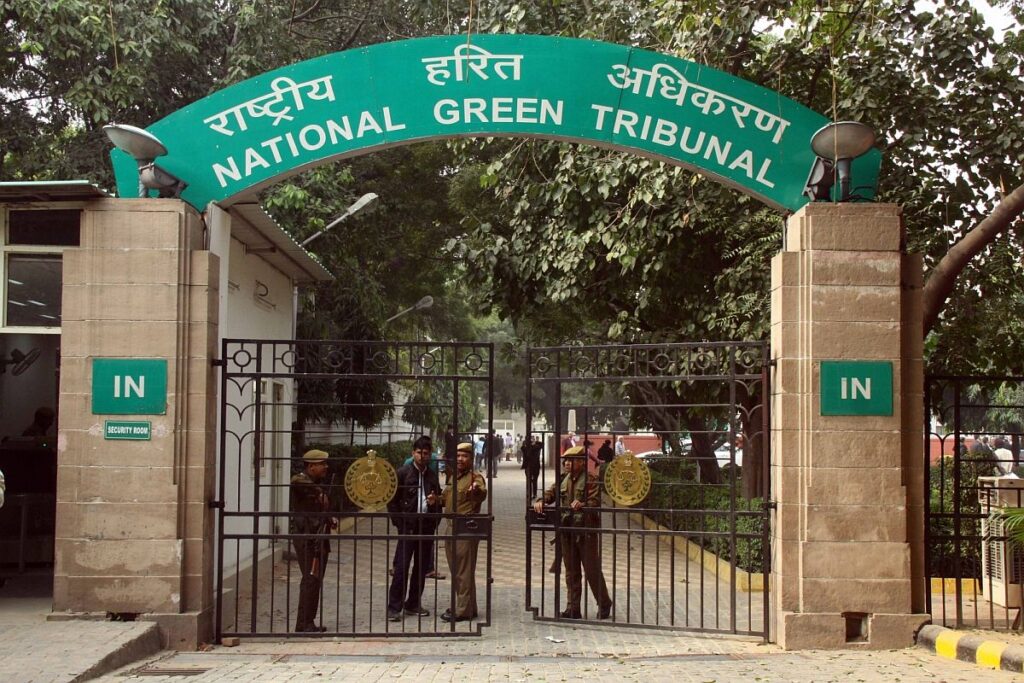By Sneha Majhi
Introduction
The National Green Tribunal of India, instituted in 2010, works to enact adjudication of environmental disputes, and contribute towards sustainable development. The NGT therefore plays an important role in the conservancy of the environment through the adjudication of environmental disputes as well as its contribution toward sustainability. Lost in this sea of nonawareness in the public eye is the efficiency of the NGT as a body responsible for strict compliance with environmental laws. This study identifies the need for public awareness over the importance of the NGT in safeguarding the environment.
Overview of the Historical Context of NGT
The National Green Tribunal, established under the National Green Tribunal Act, 2010, was established as a special forum for effective and expeditious disposal of cases related to the requirements of environmental protection and conservation of forests and other natural resources. The tribunal was established in order to promote the principles of sustainable development, precautionary principle, and the polluter pays principle (Mohan & Kachhwaha, 2021). Over the years, the NGT has been central in tackling concerns on environmental elements, such as air and water pollution, biodiversity conservation, and forest resources management.
As highlighted by Agarwal et al. (2020), the tribunal functions as a vital watchdog in environmental governance in India: the platform provides citizens with the opportunity to attain justice on issues concerning environmental degradation. Often, decisions of the tribunal entail a huge implication on the operations of industries, urban planning, and ecological sustainability. As it is seen in the case where NGT intervened and protected the Aravalli hills and the Yamuna River, its position among the players becomes even more important for environmental conservation.
Legal Framework and Functions of the NGT
This tribunal has jurisdiction over a wide range of environmental issues, including pollution control, biodiversity conservation, and protection of forests and wildlife. It entails the main legislation among which are the Environment Protection Act 1986, the Water (Prevention and Control of Pollution) Act 1974, and the Forest Conservation Act 1980, among others (Bhardwaj & Goel, 2021).
An important feature of NGT has been the “no harm” principle that demands any proposed project not to have adverse environmental impact except where measures to mitigate the impacts are undertaken. The tribunal has been proactive about taking decisions over illegal construction, pollution because of industrial activities, and the violation of the forest rights, thereby playing an important role in enforcing environmental laws (Sagar, 2022).
During its existence, the NGT has provided landmark judgments. For instance, in Indian Council for Enviro-Legal Action vs. Union of India, the tribunal focused on stringent pollution control measures. Further, NGT has been playing a critical role in addressing emergent environmental issues during this critical phase while India is still grappling with air and water pollution, solid waste management issues, and biodiversity protection (Kaur, 2023).
Non-governmental organizations may also have a strategic role in the engagement process. They could also collaborate with outreach programs that support environmental education and the promotion of sustainable activities. For instance, schemes that directly engage communities with an activity, say a tree-planting drive or pollution campaign, educates and galvanizes public action on the cause (Ghosh & Chatterjee, 2023).
The National Green Tribunal, India hastens the disposal of environmental disputes by bringing access to justice directly to affected persons. It aims to dispose of cases within six months of filing. It consists of a chairman and other members having a rich, specialized knowledge in the field of environmental law and science.
Caseloads are effectively managed to allow for interim orders that can prevent environmental harm in the conduct of the proceedings. Applications are made directly at the NGT so as to facilitate public interest litigation. Decisions will enforce compliance with environmental regulations. Decisions may be complemented with penalties or remediation orders, and appeals may even be made to the Supreme Court (Mishra, 2018).
Most of the cases are settled in practice within a short time frame, thus helping improve India’s environmental governance. In addition, the tribunal increases awareness and public participation in environmental protection issues (Ghosh, 2017).
Public Awareness and Engagement
Despite the very good track record that NGT has, much awareness on its mandate, how it works, and avenues of public participation is needed. It can be best done through educational outreach programs, such workshops, and community engagement exercises that will give better understanding to citizens about environmental rights (Rajput, 2021). Even posting orders online or granting public access to hearings has been undertaken by the tribunal in order to increase community involvement in environmental advocacy (Mehta, 2024).
This lack of awareness about the NGT also translates to fewer public participation in environmental matters. Most of the time, affected communities will be oblivious to their rights under different environmental statutes and, thus, are incapable of seeking remedies. Grassroots movements and local community engagement through information dissemination campaigns could empower citizens to participate more actively in environmental governance (Singh, 2022).
Plans for Enhancing Public Awareness
Awareness can be enhanced with various strategies related to how NGT works in terms of preserving and protecting the environment:
Awareness Campaign: Mass educational programs for schools, colleges, and social institutions make people aware of NGT and the work it does. Organized workshops, seminars, and webinars will involve different sections and engross them with in-depth knowledge regarding environmental acts and rights as well (Kumar & Aggarwal, 2019).
NGO Partnerships: NGOs are an important avenue through which environmental information and awareness and advocacy campaigns are made possible. With the support of partnerships with NGOs, NGT can extend its reach by conducting campaign activities, community meetings, and local activities where information is passed down to those most affected by deteriorating environments (Chaudhary, 2020).
Media utilization: The input could be multiplied if it makes use of other kinds of media like print media, digital media and media used in social media. Engaging cases, documentaries, and articles by establishing successful cases can be used in order to show that the real impact on the NGT on societies and nature.
Interactive Platforms: Interactive platforms, such as mobile application or website, can easily be accessed to acquire information about rights in the environment and the procedure of NGT. Such platforms would also include FAQs, case studies, and guide steps on how to file complaints or cases before NGT (Sharma, 2020).
Citizen Participation: Citizen participation in local environmental governance initiatives can also help create ownership for the efforts of conserving. Involving citizens in monitoring the quantities of pollutants, or by participation in cleaning drives or clean-up campaigns, can strengthen the reasons for environmental protection and enforcing measures through law (Ghosh, 2017).
Public Interest Litigation Clinics: The concept of initiating litigation clinics in universities can be strikingly functional to provide students with an actual realest exposure in the domain of environmental law while, simultaneously and at once, sensitizing communities. They could operate right amid the affected population to find their way through the structure of the law and know the role of NGT (Kumar & Aggarwal, 2019).
Conclusion
The National Green Tribunal is poised to play an indispensable role in the dispensation of environmental justice in India. That notwithstanding, however, the efficaciousness of the NGT rests largely in the hands of public awareness and involvement. After all, education of both the individual and the community on issues regarding the NGT and its functions will empower the stakeholders to come out forthrightly and participate actively in efforts of conserving the environment. In this scenario, the country will be able to build an informed citizenry that knows its rights and responsibilities. This will only serve to strengthen the impact of the NGT for healthier living conditions for everybody.
By filling this awareness gap, NGT, while performing the function, will contribute towards accountability and the development of responsible environmental stewardship. Since India faces a multitude of environmental issues, the role played by NGT assumes an even more pivotal nature; and public awareness would there be seen to be an integral part of the country’s efforts towards sustainable development.
References
Agarwal, S., & Kachhwaha, A. (2020). Role of the National Green Tribunal in environmental governance in India. Journal of Environmental Law & Policy, 12(2), 145-162.
Bhardwaj, P., & Goel, A. (2021). Accountability and the National Green Tribunal: A study of its jurisdiction and functions. Indian Journal of Environmental Law, 11(1), 101-116.
Chaudhary, R. (2020). NGO partnerships in environmental advocacy: Leveraging community engagement. Environmental Policy and Governance, 30(6), 230-240.
Ghosh, P. (2017). Improving public participation in environmental governance: The role of the National Green Tribunal. Environmental Justice, 10(3), 85-92.
Ghosh, P., & Chatterjee, A. (2023). Grassroots movements for environmental protection: The role of community engagement. Sustainable Development, 31(1), 10-18.
Kaur, H. (2023). Public engagement as a tool in addressing issues with solid waste management and biodiversity protection. International Journal of Environmental Science and Technology, 20(3), 1234-1245.
Kumar, R., & Aggarwal, S. (2019). Public awareness strategies: An assessment of NGT’s environmental justice initiatives. Journal of Indian Law and Society, 10(2), 75-93.
Mehta, S. 2024. Community engagement through transparency: an analysis of NGT’s digital implementations. Indian Journal of Environmental Studies, 19(1), 5-20.
Mishra, A. (2018). National Green Tribunal: the pillar of environmental justice in India. Environmental Law Review, 20(4), 275-289.
Mohan, S., & Kachhwaha, A. (2021). The National Green Tribunal: Evolution, challenges, and opportunities. The Journal of Environmental Law, 33(2), 267-284.
Rajput, S. (2021). Educational outreach and public engagement in environmental law. International Journal of Legal Studies, 12(1), 43-60.
Sagar, R. (2022). The impact of the National Green Tribunal on environmental litigation. Indian Journal of Environmental Law, 11(2), 55-75.
Sharma, P. (2020). Using technology for environmental awareness: A study of interactive platforms. Journal of Environmental Education, 41(3), 145-158.
Singh, A. (2022). Empowering citizens through grassroots movements for environmental protection. Sustainability, 14(9), 560-575.
Varma, L., & Desai, R. (2023). Role of community participation in sustainable environmental governance. Asian Journal of Environmental Science, 18(2), 95-110.
Jain, N., & Singh, R. (2021). Environmental litigation and public participation in India. Indian Journal of Environmental Law, 13(1), 22-40.
Bhatt, M., & Reddy, R. Challenges facing the National Green Tribunal in its mandate. Environmental Law Journal, 29(3), 201-213.
Kapoor, V. Digital platforms for enhancing environmental consciousness among citizens. Journal of Environmental Studies, 22(4), 393-406.
Rathi, S., & Sharma, M. (2019). Public interest litigation and its impact on environmental justice in India. Journal of Law and Environment, 15(2), 111-125.
Nath, P., & Ghosh, T. (2019). The future of environmental law in India: Prospects and challenges. Journal of Environmental Policy and Planning, 21(5), 625-636.
Thomas, D. (2023). The role of educational institutions in promoting environmental awareness. International Journal of Environmental Education, 45(1), 25-42.
Paul, A., & Kaur, J. (2022). Environmental NGOs: Building bridges between citizens and the NGT. Global Environmental Change, 67, 102236.
Sen, R. (2024). The efficacy of the National Green Tribunal in tackling pollution cases. Journal of Environmental Law, 36(1), 48-67.
Nair, A. (2021). The balance between development and environmental protection: The NGT’s approach. Indian Journal of Environmental Studies, 17(2), 59-78.
Agarwal, R., & Joshi, S. 2020. Community-led conservation initiatives and their impact on local ecosystems. Sustainable Development, 28(4), 677-688.
Vajiram & Ravi. (n.d.). National Green Tribunal. Retrieved October 17,2024 from https://vajiramandravi.com/upsc-daily-current-affairs/prelims-pointers/national-green-tribunal/





